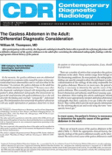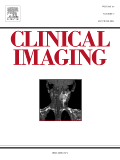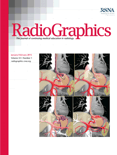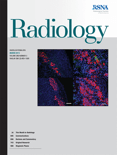
EUROPEAN RADIOLOGY
Scope & Guideline
Catalyzing Breakthroughs in Imaging Technologies
Introduction
Aims and Scopes
- Clinical Imaging Techniques:
The journal covers a wide range of imaging modalities including MRI, CT, ultrasound, and PET, highlighting advancements and comparative studies that enhance diagnostic precision. - Radiomics and AI Applications:
A significant focus is on the application of radiomics and artificial intelligence in imaging, with studies exploring predictive modeling, automated diagnosis, and machine learning algorithms to improve clinical decision-making. - Interventional Radiology:
Research articles often discuss techniques and outcomes related to interventional procedures, including ablation therapies, biopsies, and minimally invasive treatments, reflecting the journal's commitment to practical applications in patient care. - Oncology Imaging:
The journal features numerous studies on cancer imaging, including the assessment of tumor response to therapies, prognostic indicators, and the role of imaging in treatment planning for various cancers. - Standardization and Guidelines:
A consistent theme is the development and validation of guidelines and scoring systems (e.g., LI-RADS, PI-RADS) to standardize imaging practices and improve communication among healthcare professionals. - Emerging Technologies:
The journal also explores emerging imaging technologies such as photon-counting CT, advanced MRI techniques, and new contrast agents, emphasizing their potential impact on the future of radiology.
Trending and Emerging
- Artificial Intelligence and Machine Learning:
There is a significant uptick in studies utilizing AI and machine learning for diagnostic purposes, indicating a strong trend towards automated analysis and enhanced decision-making in radiology. - Personalized Medicine and Imaging Biomarkers:
Emerging research focuses on the development of imaging biomarkers that assist in personalizing treatment plans, particularly in oncology, emphasizing the importance of tailored patient care. - Multimodal Imaging Approaches:
The integration of multiple imaging modalities (e.g., combining MRI with PET or CT) is on the rise, reflecting a trend towards comprehensive diagnostic strategies that enhance detection and characterization of diseases. - Radiomics for Prognostic Assessment:
Studies applying radiomics for prognostic assessment in various cancers are increasingly common, showcasing the potential of imaging data to predict treatment responses and outcomes. - Quality Assurance and Standardization Efforts:
There is a growing emphasis on the need for quality assurance in imaging practices and the establishment of standardized reporting systems to improve the consistency and reliability of radiological assessments. - Patient-Centered Imaging:
Research focusing on patient-centered approaches, including the impact of imaging on patient outcomes and experiences, is emerging as a crucial aspect of radiology, highlighting the importance of considering patient perspectives in imaging practices.
Declining or Waning
- Conventional Imaging Techniques:
There is a noticeable decline in studies focusing solely on conventional imaging techniques without the integration of advanced technologies or AI, as the field moves towards more sophisticated methodologies. - Basic Radiological Education:
Research articles centered on foundational radiology education appear to be diminishing, suggesting a shift towards more specialized and advanced topics that cater to experienced practitioners. - Generalized Case Reports:
The publication of generalized case reports has decreased, with a preference for studies that present substantial data, innovative research, or significant clinical trials that contribute to the broader field. - Non-Quantitative Studies:
There is a waning interest in purely qualitative studies that do not incorporate quantitative measures or advanced imaging analysis, reflecting a trend towards data-driven research. - Traditional Imaging Guidelines:
Research related to older imaging guidelines or classifications that lack contemporary relevance has declined as the focus shifts to updated frameworks and new technologies.
Similar Journals

European Radiology Experimental
Leading the Charge in Open-Access Radiology ResearchEuropean Radiology Experimental is a premier open-access journal published by Springer Wien, dedicated to advancing the field of radiology through innovative research and experimentation. Since its establishment in 2017, the journal has quickly gained recognition, evidenced by its impressive Q1 ranking in the Radiology, Nuclear Medicine and Imaging category, and its placement within the top 83rd percentile of the Scopus rankings. Based in the United Kingdom, this journal aims to bridge the gap between clinical practice and cutting-edge research, providing a platform for rigorous peer-reviewed articles that explore new methodologies, technologies, and insights in radiological sciences. With a commitment to open access, European Radiology Experimental ensures that its content is readily accessible to a global audience, supporting the dissemination of knowledge and fostering collaborations among researchers, professionals, and students in the medical imaging community. As it progresses through its convergence years, the journal continues to play a vital role in shaping the future of radiological research and practice.

Contemporary Diagnostic Radiology
Shaping the Landscape of Radiological ScienceContemporary Diagnostic Radiology is a pivotal journal in the field of medical imaging and radiology, published by Lippincott Williams & Wilkins. With an ISSN of 0149-9009 and an E-ISSN of 1938-1395, this journal serves as an essential platform for disseminating high-quality research and advances in diagnostic radiology and related disciplines. While it is categorized in the lower quartiles (Q4) for its performance in the 2023 rankings in both Neurology, Radiology, Nuclear Medicine and Imaging, and Surgery, its focus on emerging technologies and methodologies in imaging continues to provide valuable insights for practitioners and researchers alike. The journal’s scope includes innovative diagnostic tools, imaging techniques, and case studies, fostering collaboration and knowledge sharing in the medical community. Although it does not offer open access options, its commitment to contributing to the ongoing dialogue in clinical imaging is undisputed, making it an essential resource for professionals seeking to stay abreast of current trends and research in the rapidly evolving landscape of diagnostic radiology.

European Journal of Radiology Open
Empowering Radiology Research for a Global AudienceThe European Journal of Radiology Open, published by Elsevier, has established itself as a pivotal platform for disseminating high-quality research in the field of radiology, nuclear medicine, and imaging since its inception in 2014. This open access journal, holding a commendable Q2 ranking in the esteemed 2023 Scopus categorization, seeks to foster a collaborative environment where researchers, professionals, and students can share innovative findings and advancements. Operating under the E-ISSN 2352-0477, this journal contributes to the broader scientific discourse with a commitment to accessibility and transparency, ensuring that cutting-edge research is available to a global audience. The journal's dual focus on rigorous peer review and rapid publication processes underscores its importance within the academic community, aiming to empower professionals with the latest insights in the dynamic landscape of medical imaging.

SA Journal of Radiology
Connecting Ideas: The Heartbeat of Radiological ScienceThe SA Journal of Radiology is a prominent open-access journal published by AOSIS, dedicated to advancing knowledge in the fields of Radiology and Ultrasound Technology. Established in 2004, this South African journal provides a platform for researchers, professionals, and students to disseminate valuable findings and share innovative practices in medical imaging. With an ISSN of 1027-202X and an E-ISSN of 2078-6778, the journal has become an important resource for those involved in radiological sciences, despite currently holding a Q4 ranking in both Radiological and Ultrasound Technology and Radiology, Nuclear Medicine and Imaging categories. Covering a converged time span from 2014 to 2024, the journal aims to promote scholarly communication and enhance the accessibility of research, positioning itself as a key player in the global radiological community. In a landscape where open access is increasingly critical, the SA Journal of Radiology is committed to fostering research collaboration and facilitating the exchange of ideas among clinicians and academics alike.

Clinical Imaging
Shaping Tomorrow's Imaging Techniques TodayClinical Imaging, published by Elsevier Science Inc, is a renowned journal dedicated to the field of radiology, nuclear medicine, and imaging. With an ISSN of 0899-7071 and an E-ISSN of 1873-4499, this esteemed publication has established its significance in advancing imaging science since its inception in 1989 and continues to make impactful contributions to the discipline through 2024. The journal holds a prestigious Q2 ranking in the category of Radiology, Nuclear Medicine, and Imaging, reflecting its critical role in bridging research and clinical practice. Currently ranked #113 out of 333 by Scopus, with a notable 66th percentile, it offers a platform for disseminating high-quality research, reviews, and case studies that inspire innovation and enhance imaging techniques. Although it primarily functions as a subscription-based journal, it remains dedicated to accessibility and the dissemination of pivotal findings that inform both academia and clinical settings. Clinical Imaging is essential for researchers, professionals, and students alike, offering insights that shape the future of diagnostic imaging.

RADIOGRAPHICS
Exploring Innovations in Radiological ExcellenceRADIOGRAPHICS, published by the Radiological Society of North America (RSNA), is a premier academic journal dedicated to the field of radiology, nuclear medicine, and imaging. With an impressive impact factor and recognition in the top quartile (Q1) of both Medicine (miscellaneous) and Radiology, Nuclear Medicine and Imaging categories, RADIOGRAPHICS stands out as a leading platform for disseminating high-quality research and clinical findings. Since its inception in 1985 and projected to run until 2024, the journal has consistently provided essential insights into cutting-edge imaging techniques and advancements in radiological practices, making it invaluable for professionals, researchers, and students alike. Although it does not offer open access, the journal continues to flourish with a robust reputation, ranked 35th in its field according to Scopus, placing it within the 89th percentile of its category. With an unwavering commitment to enhancing the understanding and application of radiological sciences, RADIOGRAPHICS remains a pivotal resource for advancing knowledge and expertise within the medical community.

RADIOLOGY
Shaping the future of radiology, one article at a time.RADIOLOGY, published by the Radiological Society of North America (RSNA), stands as a premier journal in the fields of radiology, nuclear medicine, and imaging. Established in 1945, this esteemed journal has consistently provided groundbreaking research and insights, helping to shape advancements in diagnostic imaging and therapeutic interventions. With a commendable Q1 ranking in its category and a remarkable 99th percentile ranking in Scopus, RADIOLOGY continues to be a pivotal resource for clinicians, researchers, and students alike. Although not an Open Access journal, it offers a wealth of high-quality peer-reviewed articles that contribute significantly to the ongoing discourse in the medical community. With a strong focus on innovative techniques and the integration of new technologies, RADIOLOGY remains essential for professionals aiming to stay at the forefront of medical imaging practices.

Radiologie
Connecting Radiological Science to Clinical ExcellenceRadiologie, published by SPRINGER HEIDELBERG, is an emerging journal dedicated to the fields of radiology, nuclear medicine, and imaging. With an ISSN of 2731-7048 and E-ISSN 2731-7056, this journal does not currently offer open access, providing a traditional yet respected platform for scholarly communication. Founded in 2022, it aims to advance the understanding of cutting-edge imaging techniques and their applications in clinical practice, contributing to improvements in diagnostic accuracy and patient care. Despite its recent establishment, Radiologie is positioned within the Q4 quartile category, reflecting its developing presence in the academic landscape, with a current Scopus rank of #231 out of 333 in its category. The journal serves as a vital resource for researchers, professionals, and students seeking to stay abreast of the latest developments in radiological science, imaging technology, and their clinical implications, ensuring ongoing engagement and advancement in this critical area of healthcare.

Egyptian Journal of Radiology and Nuclear Medicine
Empowering Knowledge in Radiology and Nuclear MedicineThe Egyptian Journal of Radiology and Nuclear Medicine, published by Springer, is a premier open access journal that has provided valuable insights and advancements in the fields of radiology and nuclear medicine since its initiation in 2010. With an E-ISSN of 2090-4762, this journal is dedicated to bridging the gap between research and clinical practice, allowing for the dissemination of high-quality research to a global audience. Situated in Germany, it enjoys a robust reputation in the academic community, evidenced by its categorization in the Q3 quartile for 2023, as well as its Scopus ranking, where it holds a position of #225 out of 333 in the domain of Radiology, Nuclear Medicine and Imaging, placing it in the 32nd percentile. The journal's open access model ensures that researchers, professionals, and students can freely access innovative studies, reviews, and case reports that discuss the latest methodologies, technological advancements, and clinical outcomes in radiology and nuclear medicine. As it looks toward its converged years spanning from 2010 to 2024, the Egyptian Journal of Radiology and Nuclear Medicine continues to be an essential resource for advancing knowledge and fostering ongoing collaboration in these critical fields.

Journal of the Belgian Society of Radiology
Empowering Radiologists with Open Access InsightsThe Journal of the Belgian Society of Radiology, published by UBIQUITY PRESS LTD, is a pivotal resource in the field of radiology, nuclear medicine, and imaging. With an ISSN of 2514-8281 and E-ISSN of 2514-8281, this open access journal has been dedicated to fostering the dissemination of high-quality research since its establishment in 2010. Distributed from the United Kingdom, it offers a platform for innovative studies, case reports, and reviews that contribute to the advancement of radiological sciences. Despite its current Q4 category ranking within Scopus, the journal plays a critical role in sharing essential findings with a community of over 1,200 professionals and students eager to stay abreast of emerging trends and technological advancements in imaging. By enabling unrestricted access to its publications, the journal encourages collaborative research and knowledge exchange that transcends geographic boundaries, solidifying its importance for both established researchers and emerging scholars in the discipline.